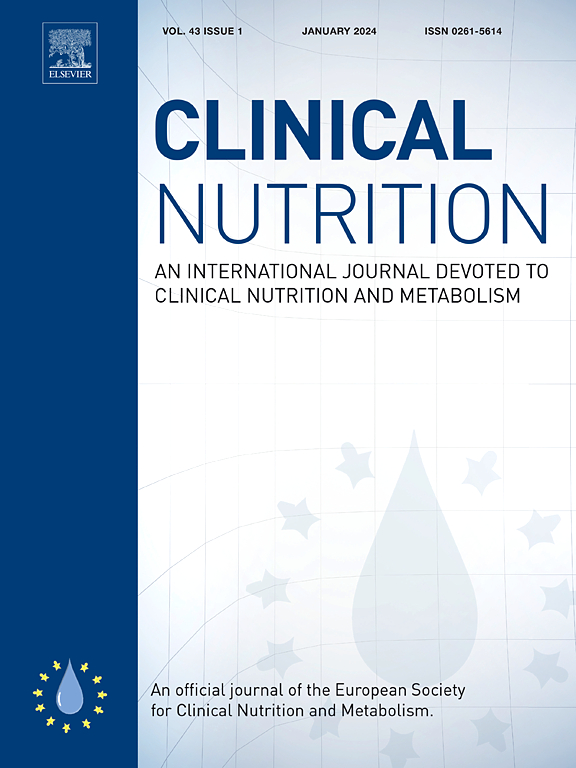不同铁螯合剂对输血依赖性β-地中海贫血患儿补充维生素E 12个月后的氧化应激标志物和组织铁超载:一项随机安慰剂对照试验
IF 6.6
2区 医学
Q1 NUTRITION & DIETETICS
引用次数: 0
摘要
维生素E是一种抗氧化剂,在地中海贫血中由于铁超载而耗尽。我们研究了维生素E作为铁螯合剂辅助治疗输血依赖性地中海贫血患者与组织铁超载相关的有效性和安全性,并研究了其对氧化应激标志物包括过氧化物还毒素2 (PRDX2)的潜在纠正价值。方法:本随机前瞻性研究纳入180例输血依赖性β-地中海贫血患儿,将其平均分为三组,分别接受去铁胺(DFO)、去铁素(DFP)或去铁素(DFX)治疗。每组患者进一步随机接受维生素E补充(每天400毫克)或相匹配的安慰剂。患者随访12个月,通过磁共振成像评估氧化应激标志物(丙二醛[MDA]、还原性谷胱甘肽、超氧化物歧化酶、谷胱甘肽过氧化物酶和PRDX2)、血清铁蛋白(SF)、肝铁含量(LIC)和心脏T2 *。主要终点是各组之间从基线到12个月的LIC变化。结果维生素E治疗组输血指数、SF、LIC显著降低,血红蛋白、心肌T2 *均升高。与基线水平或安慰剂相比,补充维生素E后,丙二醛水平降低,而所研究的抗氧化剂得到改善。与DFO或DFP亚组相比,dfx治疗的患者血红蛋白水平最高,SF、LIC和MDA水平最低。结论维生素E是一种安全的辅助抗氧化治疗,可增强DFX减轻输血依赖性β-地中海贫血患者铁负荷的疗效。该试验注册编号为ClinicalTrials.gov。NCT06509581。本文章由计算机程序翻译,如有差异,请以英文原文为准。
Oxidative stress markers and tissue iron overload after 12-months vitamin E supplementation for children with transfusion-dependent β-thalassemia on different iron chelators: A randomized placebo-controlled trial
Background
Vitamin E is an anti-oxidant depleted in thalassemia as a result of iron overload.
Aim
We investigated the efficacy and safety of vitamin E as an adjuvant therapy to iron chelators in transfusion-dependent thalassemia patients in relation to tissue iron overload and examine its potential corrective value to oxidative stress markers including peroxiredoxin-2 (PRDX2).
Methods
This randomized prospective study included 180 pediatric patients with transfusion-dependent β-thalassemia who were equally divided into three groups to either receive desferrioxamine (DFO), deferiprone (DFP) or deferasirox (DFX). Patients in each group were further randomized to receive vitamin E supplementation (400 mg daily) or matching placebo. Patients were followed-up for 12 months with assessment of oxidative stress markers (malondialdehyde [MDA], reduced glutathione, superoxide dismutase, glutathione peroxidase and PRDX2), serum ferritin (SF), liver iron content (LIC) and cardiac T2∗ by magnetic resonance imaging. The primary endpoint was the change between groups from baseline to 12 months as regards LIC.
Results
After vitamin E therapy, transfusion index, SF and LIC were significantly decreased while hemoglobin and cardiac T2∗ were elevated compared with baseline levels or placebo group. MDA levels were decreased while the studied antioxidants were improved after vitamin E supplementation compared with baseline levels or placebo. DFX-treated patients had the highest hemoglobin level with the lowest SF, LIC and MDA levels compared with DFO or DFP subgroups.
Conclusions
Vitamin E is a safe adjuvant anti-oxidant therapy that potentiates the efficacy of DFX in reducing iron burden in transfusion-dependent β-thalassemia patients.
This trial was registered under ClinicalTrials.gov Identifier no. NCT06509581.
求助全文
通过发布文献求助,成功后即可免费获取论文全文。
去求助
来源期刊

Clinical nutrition
医学-营养学
CiteScore
14.10
自引率
6.30%
发文量
356
审稿时长
28 days
期刊介绍:
Clinical Nutrition, the official journal of ESPEN, The European Society for Clinical Nutrition and Metabolism, is an international journal providing essential scientific information on nutritional and metabolic care and the relationship between nutrition and disease both in the setting of basic science and clinical practice. Published bi-monthly, each issue combines original articles and reviews providing an invaluable reference for any specialist concerned with these fields.
 求助内容:
求助内容: 应助结果提醒方式:
应助结果提醒方式:


